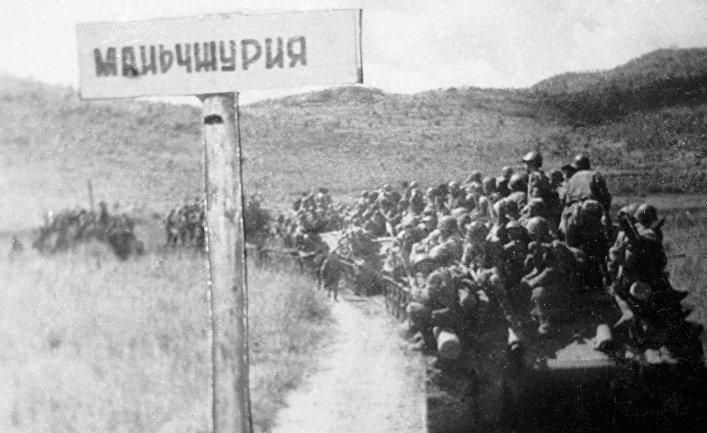[Special coverage] Secret service enacted an important role in the USSR victory in WWII

“August Storm” operation ensured the end of World War II. Photo: RIA Novosti, Alexander Stanovov.
The Great Patriotic War of 1941-1945 was a severe test for Soviet state security agencies. Сounterintelligence agents unprepared for work in wartime had to reorganize in process in the conditions of an acute shortage of personnel and technical equipment. Nevertheless, during the war the best qualities of the ‘chekists’ were manifested: courage, fidelity to duty, operational risk, the effectiveness of intelligence and counterintelligence actions to introduce the enemy intelligence network and system of intelligence and sabotage structures. Vladimir Pnev specially for the Pan Pacific Agency.
The security agencies reorganized their work to wartime conditions in a relatively short time. They developed new forms and methods of dealing with the subversive activities of the special services of fascist Germany and its allies. In the combat zone of the Red Army, military counterintelligence agents created an effective system of measures to combat enemy agents, making a significant contribution to the victory of the Soviet people, protecting our Armed Forces from enemy spies, saboteurs, and terrorists, protecting the operational plans of the Soviet command from the enemy.
Despite the non-aggression pact concluded in April 1941, the Japanese militaristic government secretly prepared for war against the USSR. The Japanese General Staff collected military, political and economic spy data on troops and defense facilities in the Soviet Far East. The main governing body of Japanese intelligence and counterintelligence in the territory of Manchuria was the 2nd department of the headquarters of the Kwantung Army, stationed in Changchun, the former capital of Manzhou-Guo.
Before the start of the war with Japan, the state security agencies had information on the structure, deployment and subversive activities of Japanese intelligence agencies. They were aware of the whereabouts of the leaders of anti-Soviet organizations and were provided with lists of persons to be searched and arrested. This greatly facilitated the work and made it more purposeful. For example, the Chekists knew that the former chieftain Semenov permanently lived in the village of Kakasashi, 20 km from the city of Dalniy. For his capture, operational workers of the 6th Panzer Army WRC Division were sent there along with advanced units of the Red Army, who on August 25, 1945 detained Semenov in the city of Dalniy (Dalian).
The KGB operative groups, along with the landing forces and advanced units of the Red Army, entered cities and large settlements, primarily to the places where the Japanese intelligence services were stationed, seized the premises of the former Japanese intelligence and police agencies, various White emigre organizations. The captured archival documents of Japanese intelligence and white emigrant organizations made it possible to identify and detain official employees and agents of Japanese intelligence. Also established were Japanese residencies operating in the Soviet Union, identified persons who were transferred to Soviet territory for espionage activities or recruited in the USSR. For example, during the occupation of the Manchurian station by the Red Army, the operative group of the Smersh counterintelligence department of the 36th army found a spy network organization scheme among captured documents that determined that one of the Japanese residents had agents at a number of points in the Manchu branch of the Trans-Baikal Railway . All of these agents were arrested.
Along with the implementation of counterintelligence measures, Chekist operational groups took part in the misinformation of the enemy, which to some extent contributed to the successful conduct of military operations against the aggressive actions of the Japanese imperialists.
On the territory liberated by the Red Army, task forces conducted counterintelligence work, were engaged in filtering Japanese prisoners of war, and acquired agents among them with a view to their subsequent withdrawal to Japan. As a result, a number of Japanese intelligence officers and agents were exposed, part of the archives of the Japanese military and naval missions were seized, members of the large Asano sabotage detachment were identified and neutralized. During filtering activities in the camps and at prisoner-of-war gathering points of the Kwantung and Manchurian armies with the help of identifying agents it was possible to identify and detain the official employees of Japanese intelligence agencies and their agents, including the head of the Hailar military mission Amano, the head of the military mission in Qiqihar Tanak about and others.
The state security organs arrested a number of senior officials of the Harbin mission, including its head General Yanagita, the implacable enemy of the Soviet government Baksheev – deputy chieftain Semenov, almost the entire leadership of the Russian Fascist Union, headed by Rodzayevsky, the top leadership of the Bureau for Russian Emigrants and its peripheral branches, as well as many Japanese intelligence agents.
As a result of the defeat of imperialist Japan, Japanese intelligence agencies in Manchuria, southern Sakhalin and North Korea, as well as anti-Soviet white emigrant centers, were completely eliminated.
In a stubborn and prolonged confrontation with the powerful reconnaissance and subversive machine of fascist Germany and the special services of militaristic Japan, the military Chekists, infinitely loyal to their homeland, honorably fulfilled their tasks, displaying mass heroism, showing examples of unparalleled courage and bravery in carrying out combat and operational missions, which contributed to the victory of the Soviet people in World War II.